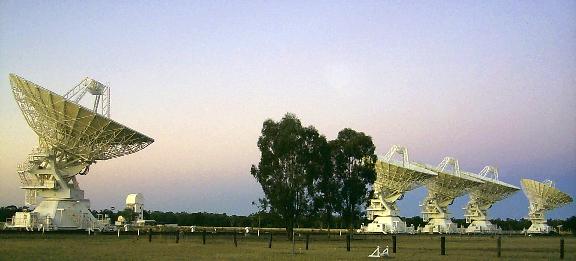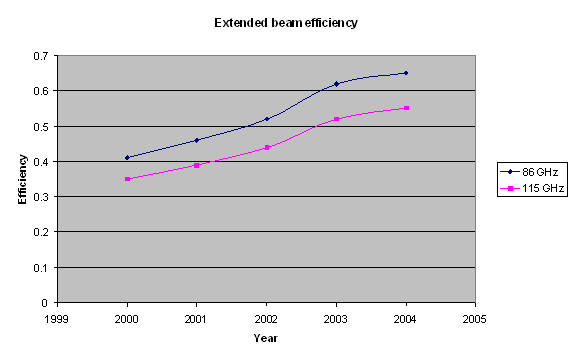Compact Array and Mopra report
Operations
The May term was a time of both major achievements and disruption. The major achievement has been the delivery of the 3-mm system (see cover article). The system was installed in mid-September, was quickly brought into operation and is scheduled to be used until 15 October when the "3-mm season" will be declared over. 12-mm observing continues until 28 October. Scheduled millimetre observing will then finish for the summer. A smaller but noted achievement was that the Array completed its 250th reconfiguration during the term.
The disruption at the Compact Array was caused by the late delivery of the 3-mm system. Although installation was expected to be completed by late June, this slipped to mid-September. This led to substantial changes in the observing schedule, at short notice to our observers. This caused a fair amount of disruption to our observers, particularly some overseas ones, and a good deal of additional work for many ATNF staff members. We are very grateful to the many observers who graciously took this disruption in their stride, and reorganised their timetables to use the Array.
Although most projects were rescheduled, the rescheduling of some was less than optimal. Additionally only three or four antennas were available to the earliest projects to use the 3-mm system. Expressed as a fraction of total time in the term, 4.6% of projects originally scheduled needed to be cancelled and replaced with other projects, 1.2% observed with a three-antenna system, and 2.6% observed with a four-antenna system. The majority of projects that were cancelled were for 12-mm observations as the installation of the 3-mm system disabled the 12-mm system for a period.

Figure 1: The Array operating in split array mode. Antennas 2, 3 and 4 are being used in the AT20G survey, while antennas 1 and 5 are tracking a source to the east.
Although some rough edges still remain with the 3-mm systems, overall they are working very well. Above atmosphere system temperatures of 250K and an antenna sensitivity of about 25 Jy/K are achievable. Instrumental phase stability is excellent (the atmosphere is the limiting element). More complete characterisation and some corrective work for some issues with the system will take place after the end of the season.
For three weeks during August, the AT20G project used the telescope. This is an all-sky survey at 12 mm which makes use of an analogue 8-GHz continuum correlator and uses a fast scanning scheme to cover the sky in reasonable time. As this observing proposal used only three antennas, we were able to use the remaining three in parallel in a "split array" mode for a small number of other projects. For this we used the new LINUX-based observing system — this was its first use in anger (Figure 1).
Usage statistics
Figure 2 gives the usage statistics for the Compact Array in the 2004 May term. Not unexpectedly, the fraction of maintenance and test time was substantially higher than normal. This is a result of s three-week shutdown period in June to install many of the 3-mm systems, and test time needed for final installation and commissioning work. Lost time was also somewhat higher than normal. In part this has been caused by some failures associated with new systems (mainly the 3-mm systems), but it also reflects a small number of unusual failures that occurred during the term. The statistics do not reflect projects that were cancelled and replaced with others or the reduced antenna availability when only 3 or 4 antennas were available with the earliest use of the new 3-mm systems.
Staff
In July we bid farewell to Tim Kennedy. Tim had been with the ATNF for 10 years working as the Visitor Centre manager and being involved in a broad range of outreach activities. We thank Tim for the sterling service that he has given the ATNF over the last decade.
We also said farewell Daron Brooke who has been one of our key RF technicians for the last 6 years. Most recently he has played an important role in the installation process of the new millimetre systems. Daron has been planning on moving for personal reasons for some months. We thank Daron for all his work over many years, and most recently for seeing it through to the end of the 3-mm systems installation.
Other developments
Narrabri has been successful in securing funding for a major refurbishment and development of the Control Building. This will probably also entail an extension of the building to replace the Receiver and Cryogenics Laboratory. Plans for this project are still in the very early stage. We recently were visited by a structural engineer to assess the basic integrity of the building.
Another site facility upgrade that is currently proceeding is the replacement of the copper cabling between the Control Building, the Antenna Laboratory, the Lodge and some site houses. This cabling is used by the telephones, fire alarms and site alarms. At the same time as the copper is replaced, a conduit and new fibres will be laid. A significant impetus for this work has been the increasing amount of maintenance work required to keep the alarm systems in a healthy state. A major step was needed to address this before their reliability became critical.
The atmospheric seeing monitor measurements, which are displayed on a workstation in the Control Room, are proving a very valuable tool in understanding the atmospheric phase conditions. This is particularly important as we move into routine 3-mm operation. At the time of writing, in early spring conditions, the day to night change in the phase stability can be a factor of 10 to 20.
Recently the ancillary information being stored in the Observatory's RPFITS files has been significantly improved. The files now contain more meteorological data, reference pointing solutions, scan types, correlator configuration, seeing monitor data and logs of CAOBS commands. Observers can now enter comments that are saved with the RPFITS file and retrieved by the offline software.
Mopra
Interestingly first light for the first of the new ATCA 3-mm systems was 10 years almost to the hour of the first light with the SIS system at Mopra in 1994. Perhaps not surprisingly, the first source in both cases was the same SiO maser.
The last ATNF Newsletter noted that "Mopra has generated quite a few low-points and high-points" in the lead-up to its millimetre season. This pattern has continued into the season.
On the positive side, the work done to support fast raster mapping using Mopra has paid off. This is now a routine process to observe and reduce data in this fast scanning mode. The results coming from this are excellent. See the separate article.
Another pre-season round of adjustment of the antenna optics has helped to improve the antenna efficiency. A recent analysis of Mopra's efficiency (Ladd et al.) has shown a healthy improvement with time: the subreflector work and surface adjustments have resulted in a near doubling of the efficiency in the last four years (Figure 3). Work and assistance by the Mopra operations staff has led to a smoother observing system and to observers who are more capable of exploiting Mopra's strengths. Overall this season has probably been the most scientifically productive one for some time.

Figure 3: Change in Mopra's extended beam efficiency with time
The low points at Mopra over the season have included some persistent problems with the cryogenics system. It appears contaminants entered the cryogenic system near the start of the season, and it has taken some considerable effort to expunge them. The 3-mm SIS system at Mopra works with a superconducting junction and liquid helium (at 4 Kelvin). This cryogenic system is more complex and temperamental than other ATNF cryogenic systems. However, after four cool-downs of the receiver, it is now working very well. Along the way, however, we have had several failures of the cryogenic system which resulted in lost observing time.
Another more spectacular failure (but one that did not affect observing) was an overspeed event on the Mopra backup generator. This occurred while the generator was being repaired by an external contractor, and managed to destroy the windings in the main alternator. The situation was quickly recovered: the contractor accepted liability for the damage, a hired generator was on site within 18 hours and the ATNF generator was shipped off for major repair work.
Another notable failure was a disk crash on the observing system computer. As luck would have it, this happened a few hours before a global VLBI session.
Mopra usage
Figure 4 shows the usage statistics for Mopra from the start of the Mopra millimetre season on 22 May until 1 October. There are a number of noteworthy features. The lost time is dominated by two categories: cryogenics and weather. Cryogenics accounts for 9.3 of the 18.5% of lost time. This reflects the problems that we have experienced with the 4-Kelvin system. With the planned installation of a Compact Array-style millimetre receiver package at Mopra in 2005, we expect a much simpler and more robust cryogenic system next year. Weather accounted for 6.5 of the 18.5%, and consists of both wind stows and rain conditions. Weatherwise, Mopra has had a comparatively good season.
The idle fraction is that part of the Mopra time where the telescope has been allocated to astronomy, and was capable of observing, but where it remained stowed. This is a reflection that Mopra is largely a galactic instrument and so there is a restricted LST range where it is an attractive instrument. It also reflects that the lodge facilities at Mopra are not well suited to supporting large numbers of observers or multiple observing teams.
Bob Sault
Officer-in-Charge, Narrabri Observatory
(Bob.Sault@csiro.au)
